Hakone
last update: November 25, 2021
Hakone (箱根) is a town in Kanagawa prefecture, about 80 km from Tokyo and within the Fuji-Hakone-Izu National Park. The enchanting view of Lake Ashinoko, the nearby Mount Fuji, the volcanic area of Owakudani and the numerous hot springs make this place one of the most unmissable in the Kanto region. It is one of the most popular tourist destinations among the inhabitants of Tokyo to escape the chaos of the metropolis and relax in one of the many ryokans and onsen in Hakone, as well as by many foreign tourists visiting Tokyo who do not want to leave Japan without having tried the experience of the ritual of the traditional Japanese baths.
Things to do and things to see in Hakone
Hakone-Yumoto Onsen
Hakone-Yumoto is the most famous area in Hakone for onsen and ryokans. You can enjoy the hot springs by staying one or more nights in a ryokan (recommended), or take a bath for a few hours in one of the many public onsen open during the day. If you want to try the typically Japanese experience of the onsen, Hakone is probably one of the easiest and most recommended places because it is very popular among tourists and most people are used to having foreign customers.
Hakone-Yumoto station is also the easiest to access station, directly connected to Tokyo by the Odakyu company. However, there are many other hot springs facilities scattered throughout the vast territory of Hakone, and in particular along the shores of Lake Ashinoko.
Onsen open to the public
(non-exhaustive list)
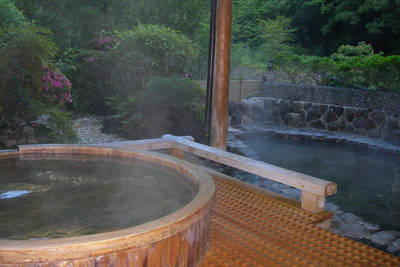
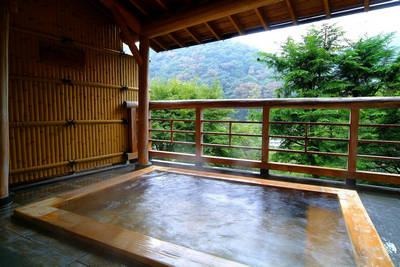 outdoor onsen at Yumoto Onsen
outdoor onsen at Yumoto Onsen
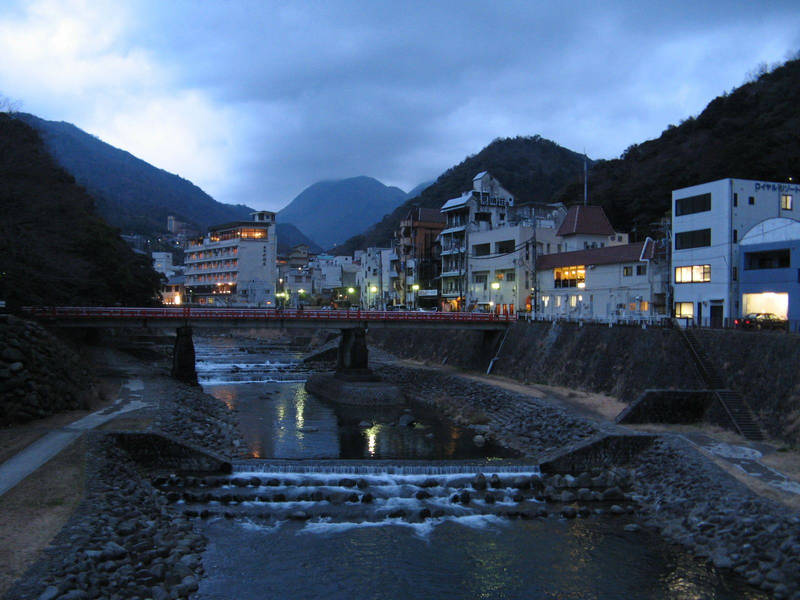 Hakone-Yumoto Onsen
Hakone-Yumoto Onsen
Along the Hakone Tozan railway line
The
Hakone Tozan Railway (箱根登山電車, Hakone Tozan Densha) is the oldest mountain railway line in Japan, about 15 km long and with a height difference of 500 meters. The lower part of the line, between Odaware and Hakone Yumoto, dates back to 1919, is also used by Odakyu trains from Tokyo and is a railway line like any other. The second section
between Hakone Yumoto and Gora, dating back to 1930, is, on the contrary, a railway line of
extraordinary charm. Small mountain trains travel through a narrow, wooded valley of the
Fuji-Hakone-Izu National Park, crossing numerous bridges and tunnels. Due to the difficult orography, the line has three switchbacks where the train changes direction. Along this second section, which takes a total of 35 minutes, there are numerous small stations, with various places of interest in the surrounding area.
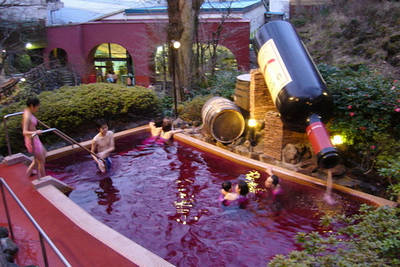
Hakone Kowakien Yunessun
(admission 3500¥/2500¥/1500¥, opening hours 10-19, 9-20 on weekends)
A large spa and relaxation complex, divided into two distinct areas. Entrance to both areas costs 3500¥. It is located about 1 km from Kowakidani station.
- Yunessun (2500¥), a real water park, where you enter in a bathing suit, with slides, outdoor spas, artificial waterfalls and swimming pools of all kinds. In particular, it is worth highlighting the presence of pools of wine, coffee, sake and green tea. You got it right, you can take a bath immersed in tubs filled with these drinks, each of which is said to have different beneficial properties.
- Mori No Yu (1500¥), a traditional onsen, with different pools, both indoor and outdoor, divided by sex and where you can bathe following the rules of the Japanese tradition, therefore only after having been thoroughly washed and completely naked. In this area you will also find saunas, and the possibility of using private onsen (for example as a couple), at a cost of 3000¥ per hour.
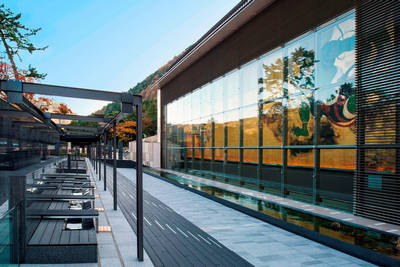
Okada Museum of Art
(admission 2800¥, opening hours 9-17)
This museum is located next to the Kowakien Yunessun spa complex, approximately 1 km from Kowakidani station. It is a private museum that exhibits a collection of works of art ranging from antiquity to the modern era. The highlight is the extensive collection of Chinese and Japanese ceramics and sculptures, and to a lesser extent also a number of Japanese paintings. The museum building is very recent (2013) and modern. The complex includes a Japanese garden (300¥), an udon restaurant and a café with thermal foot bath. For museum visitors, the thermal footbath is accessible even without consuming anything at the café, so at the end of your visit you can relax by sitting in front of a large mural depicting the god of the wind and the god of thunder. For those without a ticket to visit the museum, admission is subject to a fee (500¥).
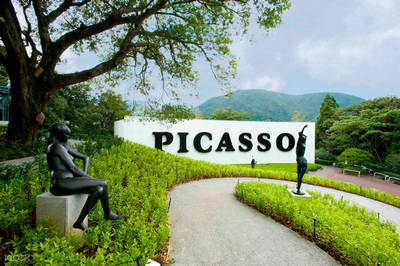
Hakone Open Air Museum
(admission 1600¥, opening hours 9-17)
This museum aims to lead the visitor on a path where art and nature are intertwined. The museum has several sections and exhibition spaces both outdoors and indoors. Outdoors, you will find numerous sculptures by local and international artists, positioned on green lawns and with views of the surrounding valleys and mountains in the background. It is located a few meters from Chokokunomori station.
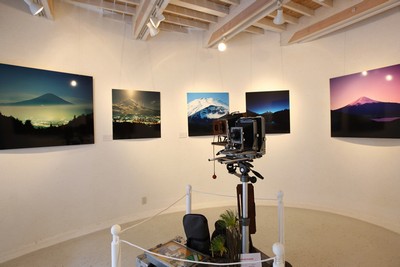
Hakone Museum of Photography
(admission 500¥, opening hours 10-17, closed on tuesdays)
A small photography museum unknown to most people, just 200 meters from Gora station
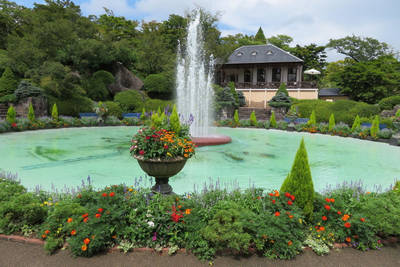
Gora Park
(admission 550¥, opening hours 9-17)
Gora Park is a French-style landscaped garden, located on a slope above Gora station, about 300 meters walk. It is a relaxing place to unwind and enjoy the landscape and views of Hakone. It features a large fountain, a rose garden, a tropical botanical garden in a greenhouse. Furthermore, inside you will find a restaurant and a tea house.
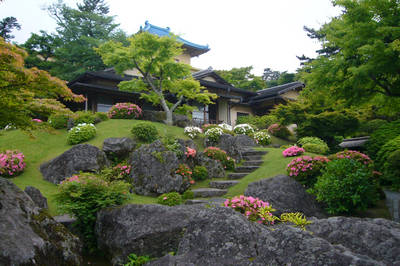
Hakone Museum of Art
(admission 900¥, opening hours 9:30-16:30, closed on thursdays)
This museum is also located near Gora station, right next to Gora Park. It mainly exhibits Japanese pottery from prehistoric times to the Edo period (1600-1868). The museum also features a fascinating moss garden and a traditional Japanese garden (Sekirakuen Garden. The former features stone paths that wind through the shade of its maple trees and a tea house. The latter is only open on weekends, public holidays and every day in November, when the magic of autumn colors attracts many visitors.
Lake Ashinoko
Lake Ashinoko (芦ノ湖, Ashinoko) was formed in the caldera of Mount Hakone after the last eruption of the volcano, which occurred about 3000 years ago. Its shores are now mostly wild, except for some small urban agglomerations to the southeast (
Moto Hakone and
Hakone Machi) and to the north (
Togendai ), which mostly house resort hotels, ryokans, restaurants and other tourist activities. Along the south shore of the lake are also several places of interest, including the Hakone Shrine, an art museum, and the reconstruction of an ancient checkpoint along the Tokyo-Kyoto route of feudal Japan.
The best views of the lake along with Mount Fuji can be enjoyed from Moto-Hakone, Onshi-Hakone Park, and from the tourist boats sailing the lake. However, the wonderful photos you can see on this site and elsewhere are taken during the rare days of good visibility (the winter months are the best). During most of the year the area is very cloudy and Mount Fuji may be invisible.
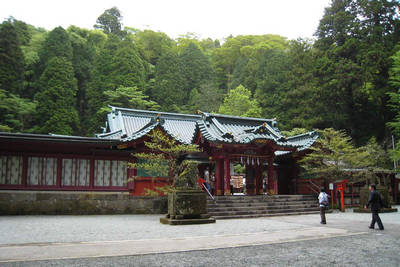
Hakone Shrine (Hakone Jinja)
(free admission, always open)
The Hakone Shrine is located at the foot of Mount Hakone along the shores of Lake Ashi. It can be reached in ten minutes on foot from Moto Hakone. The shrine buildings are hidden in the dense forest and are generally closed, but you can freely walk around the temple area with its mystical atmosphere, especially when the area is immersed in mist. You will easily notice and be fascinated by the huge red torii gates of the shrine. One is located right on the waters of the lake and is perhaps the most famous landmark of Hakone. Two others are located on the road between Moto Hakone and the shrine.
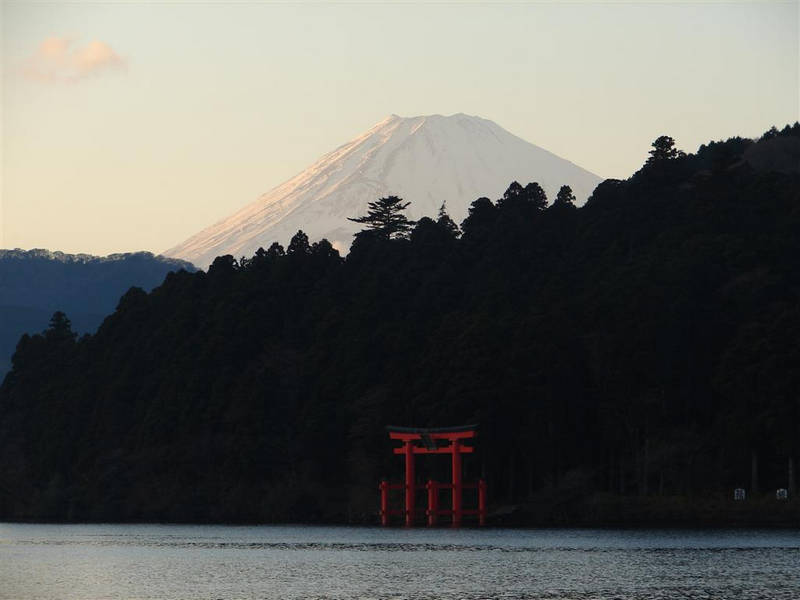 Torii (sacred gate) on Ashinoko lake
Torii (sacred gate) on Ashinoko lake
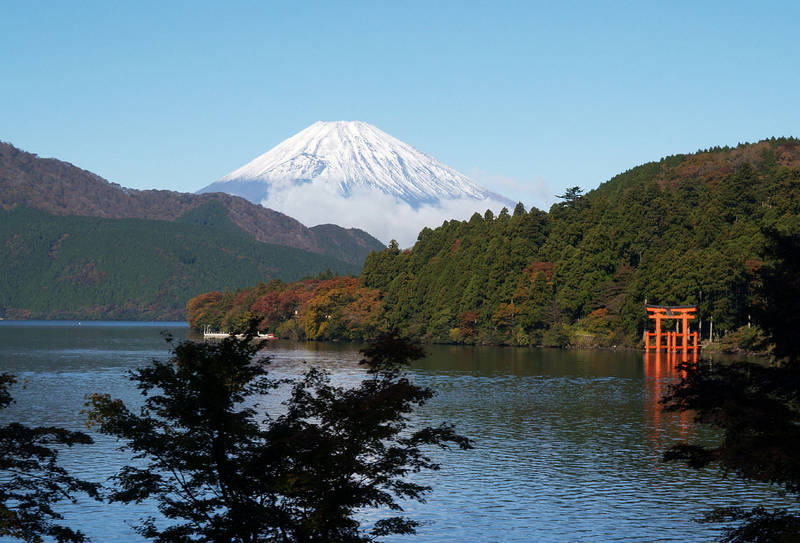 Lake Ashinoko and Mount Fuji
Lake Ashinoko and Mount Fuji
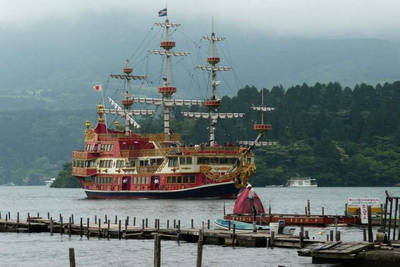
Cruise on Ashinoko Lake
Two companies offer a cruise service on Lake Ashinoko, with two piers on the southern side of the lake (Moto Hakone and Hakone-Machi) and two piers on the north side (Togendai and Kojiri). A boat cruise from one end of the lake to the other takes approximately 30 minutes and costs 1200¥. The two companies are Hakone Sightseeing Boats, with picturesque "pirate ship" style boats, and Izuhakone Sightseeing Boats, which uses smaller boats.
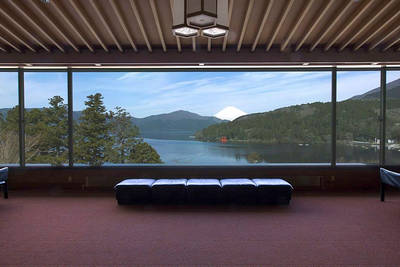
Narukawa Art Museum
(admission 1300¥, opening hours 9-17)
A contemporary art museum dedicated to the nihonga painting style. This term refers to a style that adheres to traditional conventions, techniques, tools and materials of Japanese art, and was drilled in the Meiji period (1868-1912) of the Japanese Empire to distinguish this type of painting from works made using Western techniques and materials (the latter are defined in Japanese yōga). In addition to the art collection, the museum has a café and a wonderful panoramic room overlooking the Ashinoko lake. On clear days, Mount Fuji can also be seen from here.
Onshi Hakone Park
Halfway between the two villages of Moto Hakone and Hakone machi (about 1 km from both), there is a sort of peninsula on the lake, where a large park extends with several nature trails and panoramic views of Lake Ashinoko and Mount Fuji, when the sky is clear. In the center of this park you will also find an old summer residence of the imperial family (Hakone Detached Palace, which can be visited free of charge. Of the former imperial palace complex, only a relatively small and of little interest building remains.
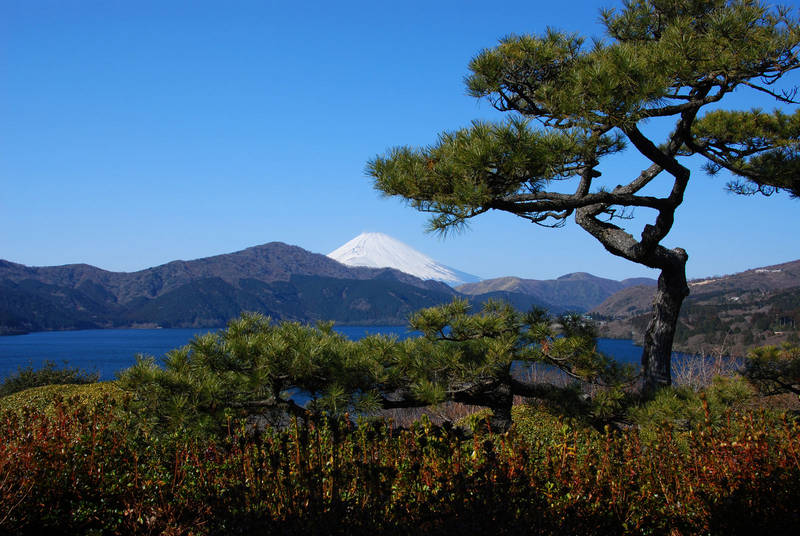 Lake Ashinoko and Mount Fuji from Onshi-Hakone park
Lake Ashinoko and Mount Fuji from Onshi-Hakone park
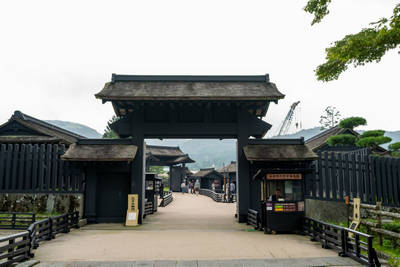
Former checkpoint along the Tokaido road (Hakone Sekisho)
(admission 500¥, opening hours 9-17)
Hakone was for a long time an important transit point along the Tokaido road that connected Tokyo with Kyoto during the feudal period. Along the shore of Lake Ashinoko, between Moto Hakone and Hakone Machi, it is possible to visit today a faithful reconstruction of a historic checkpoint of the time (sekisho in Japanese). It was the Tokugawa Ieyasu shogun (1543-1616) who ordered the construction of 53 sekisho on the main roads of the country to defend Edo (now Tokyo). The Sekisho of Hakone became one of the most important and strategic, it entered into operation in 1619 and operated for almost 260 years, finally closing in 1868.
Owakudani Valley
Owakudani (大涌谷, Ōwakudani) is an area formed during an eruption about 3000 years ago, characterized by various volcanic phenomena, including sulphurous vapors and hot springs.
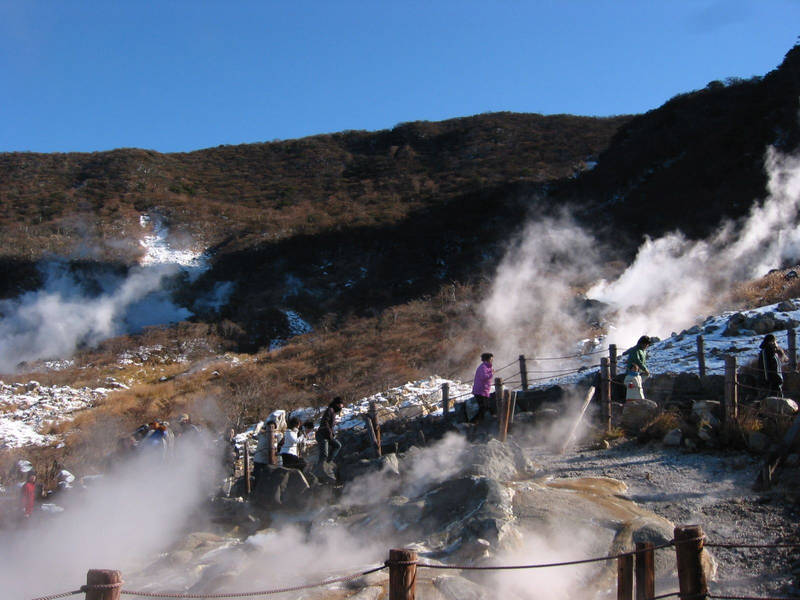 walking in the Owakudani area
walking in the Owakudani area
It can be reached via a cable car (
Hakone Ropeway) which leaves from Togendai and takes 16 minutes to climb up to Owakudani. The cable car then continues to
Sounzan, from where you can take the
Tozan cablecar (a funicular railway) to
Gora.
Very characteristic are the black eggs (
kuro tamago) cooked in the thermal waters, whose shell is dyed black due to the vapors, you can find various vendors in the area. A legend says that eating a kuro tamago extends life by 7 years.
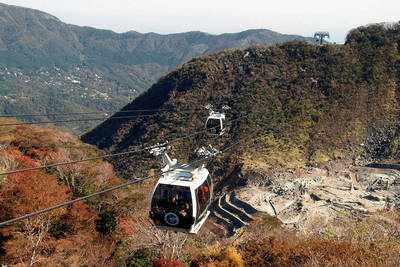
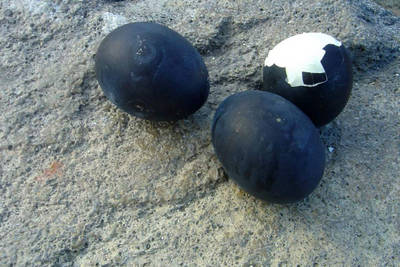 Cable car to Owakudani and the characteristic black eggs (kuro tamago)
Cable car to Owakudani and the characteristic black eggs (kuro tamago)
Where to stay in Hakone
Ryokans in Hakone Yumoto
Hakone Yumoto is packed with accommodation, of all types and for all budgets, even if the average prices are high. Sleeping in a traditional ryokan is the best way to experience first hand the magic of a stay in a Japanese spa town.
Hotels and ryokans on the shores of Lake Ashinoko
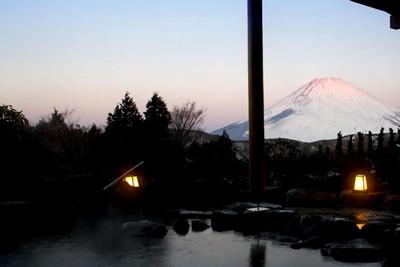 A large hotel in the woods of Hakone, accessible by cable car from the nearby Ubako stop. The same cable car, in just 10 minutes, takes you to the shores of Lake Ashinoko. The hotel is perhaps the only one in the Hakone area to offer an open-air onsen overlooking Mount Fuji, a truly unforgettable experience. Furthermore, the hotel has Western-style and Japanese-style rooms with tatami mats and futons. It is advisable to book both breakfast and dinner on site, not only because they are delicious, but also because there is nothing in the surroundings. A place to spend a relaxing night or two.
Price range: 22,000-32,000¥.
A large hotel in the woods of Hakone, accessible by cable car from the nearby Ubako stop. The same cable car, in just 10 minutes, takes you to the shores of Lake Ashinoko. The hotel is perhaps the only one in the Hakone area to offer an open-air onsen overlooking Mount Fuji, a truly unforgettable experience. Furthermore, the hotel has Western-style and Japanese-style rooms with tatami mats and futons. It is advisable to book both breakfast and dinner on site, not only because they are delicious, but also because there is nothing in the surroundings. A place to spend a relaxing night or two.
Price range: 22,000-32,000¥.
How to get to Hakone
The best solution to reach Hakone from Tokyo is to use the private company
Odakyu Railways which directly connects
Shinjuku and Hakone Yumoto. Alternatively, the JR connects Tokyo station and nearby Odawara station, both via local lines and via shinkansen.
By Odakyu Railways
Odakyu connects Shinjuku Station in Tokyo with Hakone-Yumoto Station. There are two alternatives. A first, more expensive one is to take the trains called
Romance Car (85 minutes, 2330¥). A second, much cheaper one is to take the local line to Odawara station, and then change for the last few kilometers to Hakone Yumoto (in total about 2 hours, 1220¥). A very interesting option offered by the Odakyu is the
Hakone Free Pass, which includes a round trip from Shinjuku to Hakone and unlimited use of some trains, cable cars, boats and buses in the Hakone area.
By JR
JR trains run up to Odawara Station. From there on you have to continue with the Tozai Line or by bus. From Tokyo, Odawara can be reached in 70-90 minutes via two local lines, the
Tokaido Main Line (from Tokyo station, Shinagawa) and the
JR Shonan-Shinjuku Line (from Ikebukuro, Shinjuku, Shibuya). The route costs around 1500¥ and takes 70-90 minutes depending on your departure station in Tokyo. Both lines also stop at Yokohama station.
For Japan Rail Pass holders
If you have a Japan Rail Pass, you will be happy to know that nearby Odawara station is also served by the
Tokaido Shinkansen, although not all trains but only kodama trains and occasionally hikari trains make a stop there. Thanks to high-speed trains, you can reach Odawara from Tokyo in just 30 minutes, plus another 15 minutes to Hakone Yumoto via the Tozan Line. Unfortunately the price of the shinkansen is extremely high (3810¥), so we recommend this option only if you have a Japan Rail Pass which allows you to travel for free on all JR lines (but not on the local Tozan line of Hakone).
Map of Hakone, Kanagawa
Guided tours, activities and other things to do
If you are planning a trip to Japan and you want to do something more than just visiting famous places and monuments, we suggest you to use
Rakuten Travel Experiences.
How to use Rakuten Travel Experiences
Rakuten Travel is a very useful website to
enrich your travel experience, especially if you are going solo or it's your first time in Japan.
Because of the language barrier (and more), in Japan it is very difficult to interact with the locals and to get off the tourist track.
Thanks to Rakuten Travel you can find a lot of interesting and sometimes unique
guided tours and activities all over Japan (and not only in Japan), that you would otherwise never be able to enjoy.
But there's more: on Rakuten Travel you can also
buy tickets for several famous attractions, events, transportation and other useful services for tourists. Last but not least, you can
reserve a table in hundreds of restaurants.
Some examples
Take a look at Rakuten Travel Experiences
You may also be interested in










 A large hotel in the woods of Hakone, accessible by cable car from the nearby Ubako stop. The same cable car, in just 10 minutes, takes you to the shores of Lake Ashinoko. The hotel is perhaps the only one in the Hakone area to offer an open-air onsen overlooking Mount Fuji, a truly unforgettable experience. Furthermore, the hotel has Western-style and Japanese-style rooms with tatami mats and futons. It is advisable to book both breakfast and dinner on site, not only because they are delicious, but also because there is nothing in the surroundings. A place to spend a relaxing night or two.
Price range: 22,000-32,000¥.
A large hotel in the woods of Hakone, accessible by cable car from the nearby Ubako stop. The same cable car, in just 10 minutes, takes you to the shores of Lake Ashinoko. The hotel is perhaps the only one in the Hakone area to offer an open-air onsen overlooking Mount Fuji, a truly unforgettable experience. Furthermore, the hotel has Western-style and Japanese-style rooms with tatami mats and futons. It is advisable to book both breakfast and dinner on site, not only because they are delicious, but also because there is nothing in the surroundings. A place to spend a relaxing night or two.
Price range: 22,000-32,000¥.